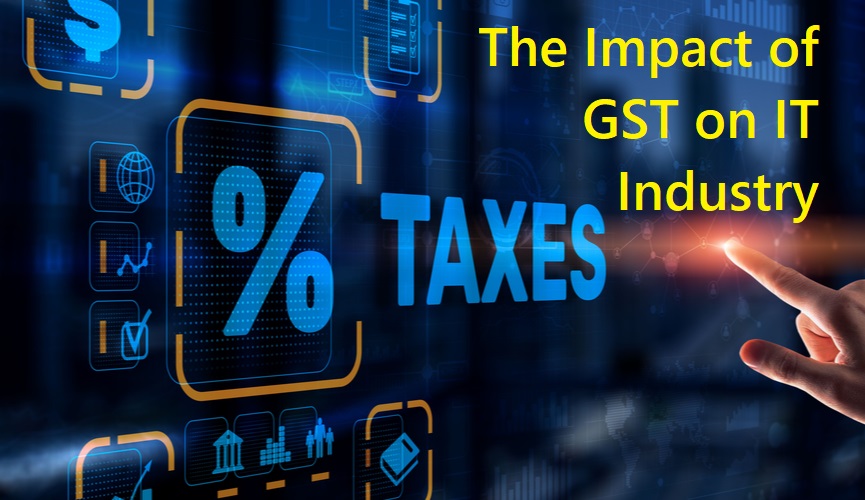The Goods and Services Tax (GST) is one of the biggest indirect tax reforms in India that was implemented on July 1, 2017. The GST replaced several indirect taxes like excise duty, service tax, VAT, etc. and introduced a single tax regime for the entire country. This new tax regime has had a significant impact on various industries, including the Information Technology (IT) sector.
The IT sector is one of the fastest-growing industries in India and has been contributing significantly to the country’s economy. The sector includes various segments like software development, hardware manufacturing, IT-enabled services, and e-commerce. The introduction of GST has brought about significant changes in the taxation structure of the IT industry.

Taxation system under VAT/Excise/service tax
In the previous tax regime, packaged software sales were subject to both VAT and service tax. The VAT rate is around 5% in most states and the service tax rate is 15%. Consumption tax also applies to IT products. Example: If the software is delivered on CD, DVD or hard drive, three taxes apply.
- Excise tax on production
- VAT on sales
- Service tax on providing a service as the software can be downloaded multiple times.
Tax rates under GST
GST in the IT sector is increased by 18% for software services provided by development companies.
The impact of GST on the IT sector has been significant, and it has led to both opportunities and challenges. The GST rates on IT services in India vary based on the type of service provided. Here are the GST rates for some of the commonly provided IT services in India:
- Software development services: Software development services are classified as “pure services” under the GST regime and are subject to an 18% GST rate.
- IT-enabled services (ITES): ITES are also classified as “pure services” and are subject to an 18% GST rate.
- Maintenance or repair services for computer hardware: Maintenance or repair services for computer hardware are classified under the category of “repair and maintenance services” and are subject to an 18% GST rate.
- Website designing and development services: Website designing and development services are also classified as “pure services” and are subject to an 18% GST rate.
- E-commerce marketplace services: E-commerce marketplace services are classified as “intermediary services” and are subject to an 18% GST rate.
- Cloud computing services: Cloud computing services are classified as “services related to information technology” and are subject to an 18% GST rate.
- Telecommunication services: Telecommunication services such as internet and broadband services are classified as “telecommunication services” and are subject to an 18% GST rate.
- Freelancing services: In India, these services are typically classified as “services related to information technology” and are subject to an 18% GST rate. This means that if you are a freelancer providing services such as website development, software development, content writing, or graphic design, you will have to charge your clients an 18% GST on your services.
On the positive side, the GST has simplified the tax system by introducing a uniform tax rate for goods and services across the country. This has eliminated the need for companies to deal with multiple taxes and has reduced the compliance burden on businesses. The introduction of GST has also led to a reduction in the overall tax burden on the IT sector, which has made it more competitive globally.
However, the GST has also brought about some challenges for the IT sector. One of the major challenges has been the classification of software and its tax treatment under the new regime. The GST has classified software as a service, which has led to an increase in the tax rate for the IT sector. This has led to increased costs for software companies, which has affected their profitability.
Here are several ways to overcome these challenges and ensure sustainable growth for the IT industry. In this blog, we will explore some of the ways to overcome the challenges of the IT industry led by GST.
- Invest in Technology: IT companies should invest in technology to streamline their processes and reduce their compliance burden. Technology can help automate compliance processes and reduce the time and cost of filing returns. This can help IT companies to comply with GST regulations more efficiently and reduce their compliance burden.
- Understand the GST Regulations: IT companies should have a clear understanding of the GST regulations and their implications on their business. Companies should invest in training and education to ensure that their employees understand the GST regulations and can comply with them.
- Implement GST-Compliant Systems: IT companies should implement GST-compliant systems to ensure that they can comply with GST regulations. This includes upgrading their accounting and billing systems to be GST-compliant. Companies should also ensure that their systems are updated regularly to ensure compliance with any changes in GST regulations.
- Maintain Accurate Records: IT companies should maintain accurate records of their transactions to ensure compliance with GST regulations. This includes maintaining records of all invoices, receipts, and other financial documents. Accurate records can help companies to comply with GST regulations more efficiently and reduce the risk of penalties for non-compliance.
- Engage with GST Consultants: IT companies should engage with GST consultants to ensure that they comply with GST regulations. GST consultants can provide guidance on compliance and help companies to understand the implications of GST on their business. They can also help companies to optimize their tax liabilities and reduce their compliance burden.






